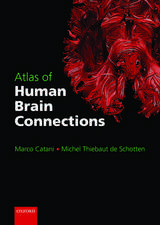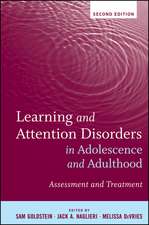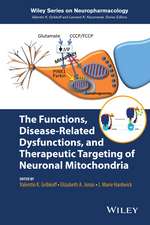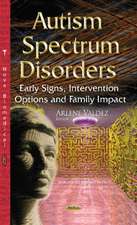Handbook of Executive Functioning
Editat de Sam Goldstein, Jack A. Naglierien Limba Engleză Paperback – 28 ian 2014
The Handbook of Executive Functioning cuts through the confusion, analyzing both the whole and its parts in comprehensive, practical detail for scholar and clinician alike. Background chapters examine influential models of EF, tour the brain geography of the executive system and pose salient developmental questions. A section on practical implications relates early deficits in executive functioning to ADD and other disorders in children and considers autism and later-life dementias from an EF standpoint. Further chapters weigh the merits of widely used instruments for assessing executive functioning and review interventions for its enhancement, with special emphasis on children and adolescents.
Featured in the Handbook:
- The development of hot and cool executive function in childhood and adolescence.
- A review of the use of executive function tasks in externalizing and internalizing disorders.
- Executive functioning as a mediator of age-related cognitive decline in adults.
- Treatment integrity in interventions that target executive function.
- Supporting and strengthening working memory in the classroom to enhance executive functioning.
| Toate formatele și edițiile | Preț | Express |
|---|---|---|
| Paperback (1) | 1978.53 lei 38-44 zile | |
| Springer – 28 ian 2014 | 1978.53 lei 38-44 zile | |
| Hardback (1) | 1991.61 lei 38-44 zile | |
| Springer – 14 noi 2013 | 1991.61 lei 38-44 zile |
Preț: 1978.53 lei
Preț vechi: 2603.32 lei
-24% Nou
Puncte Express: 2968
Preț estimativ în valută:
378.58€ • 396.34$ • 313.26£
378.58€ • 396.34$ • 313.26£
Carte tipărită la comandă
Livrare economică 01-07 aprilie
Preluare comenzi: 021 569.72.76
Specificații
ISBN-13: 9781493903375
ISBN-10: 1493903373
Pagini: 588
Ilustrații: XIX, 567 p. 43 illus.
Dimensiuni: 178 x 254 x 31 mm
Greutate: 1.01 kg
Ediția:2014
Editura: Springer
Colecția Springer
Locul publicării:New York, NY, United States
ISBN-10: 1493903373
Pagini: 588
Ilustrații: XIX, 567 p. 43 illus.
Dimensiuni: 178 x 254 x 31 mm
Greutate: 1.01 kg
Ediția:2014
Editura: Springer
Colecția Springer
Locul publicării:New York, NY, United States
Public țintă
ResearchCuprins
Preface.- SECTION I: CONCEPTUALIZATIONS OF EXECUTIVE FUNCTIONING.- Chapter 1. Introduction: A History of Executive Functioning as a Theoretical and Clinical Construct.- Chapter 2. The Physiology of Executive Functioning.- Chapter 3. The Frontal Lobes and Executive Functioning.- Chapter 4. The Development of Hot and Cool Executive Function in Childhood and Adolescence: Are We Getting Warmer?.- SECTION II: PRACTICAL IMPLICATIONS.- Chapter 5. A Review of the Use of Executive Function Tasks in Externalizing and Internalizing Disorders.- Chapter 6. The Neuropsychology of Executive Functioning and the DSM-V.- Chapter 7. Executive Functioning Theory and ADHD.- Chapter 8. Executive Functioning Theory and Autism.- Chapter 9. Executive Functioning as a Mediator of Age Related Cognitive Decline in Adults.- SECTION III: ASSESSMENT OF EXECUTIVE FUNCTIONING.- Chapter 10. Assessment of Executive Function Using Rating Scales: Psychometric Considerations.- Chapter 11. The Cambridge Neuropsychological Test Automated Battery in the Assessment of Executive Functioning.- Chapter 12. The Assessment of Executive Functioning Using the Cognitive Assessment System – Second Edition.- Chapter 13. The Assessment of Executive Functioning Using the Delis-Kaplan Executive Functions System (D-KEFS).- Chapter 14. Using the Comprehensive Executive Function Inventory (CEFI) to Assess Executive Function: From Theory to Application.- Chapter 15. The Assessment of Executive Functioning Using the Barkley Deficits in Executive Functioning Scales.- Chapter 16. Assessment of Executive Functioning with the Test of Verbal Conceptualization and Fluency (TVCF).- Chapter 17. Examining Executive Functioning Using the Behavior Assessment System for Children (BASC).- Chapter 18. The Assessment of Executive Functioning Using the Behavior Rating Inventory of Executive Functioning (BRIEF).- Chapter 19. The Assessment of Executive Functioning Using Tasks of Executive Control.- Chapter 20. The Assessment of Executive Functioning Using the Childhood Executive Functioning Inventory (CHEXI).- Chapter 21. The Assessment of Executive Functioning Using the Delis Rating of Executive Functions (D-REF).- Chapter 22. Cross Battery Approach to the Assessment of Executive Functioning.- SECTION IV: INTERVENTIONS RELATED TO EXECUTIVE FUNCTIONING.- Chapter 23. Treatment Integrity in Interventions that Target Executive Function.- Chapter 24. Interventions to Promote Executive Development in Children and Adolescents.- Chapter 25. Teaching Executive Functioning Processes: Promoting Metacognition, Strategy Use, and Effort.- Chapter 26. Working Memory Training and Cogmed to Enhance Executive Functioning.- Chapter 27. Supporting and Strengthening Working Memory in the Classroom to Enhance Executive Functioning.- Chapter 28. Building Executive Functioning in Children Through Problem Solving.- Chapter 29. Consulting with Teachers to Improve Student’s Executive Functioning.
Recenzii
From the reviews:
“The aim is to provide a clear explanation of current findings in executive function research that ‘cuts through the confusion’ and addresses practical implications. The audience for this book includes anyone interested in cognition and brain functioning, including cognitive neuroscientists, neurologists, neuropsychologists, psychologists, and psychiatrists. … The editors and authors are scholars with research experience in this field.” (Christopher J. Graver, Doody’s Book Reviews, May, 2014)
“The aim is to provide a clear explanation of current findings in executive function research that ‘cuts through the confusion’ and addresses practical implications. The audience for this book includes anyone interested in cognition and brain functioning, including cognitive neuroscientists, neurologists, neuropsychologists, psychologists, and psychiatrists. … The editors and authors are scholars with research experience in this field.” (Christopher J. Graver, Doody’s Book Reviews, May, 2014)
Notă biografică
Sam Goldstein, Ph.D., is a doctoral level psychologist with areas of study in school psychology, child development and neuropsychology. He is licensed as a psychologist and certified as a developmental disabilities evaluator in the State of Utah. Dr. Goldstein is a Fellow in the National Academy of Neuropsychology and American Academy of Cerebral Palsy and Developmental Medicine. Dr. Goldstein is an Assistant Clinical Instructor in the Department of Psychiatry. Since 1980, Dr. Goldstein has worked in a private practice setting as the Director of a multidisciplinary team, providing evaluation, case management and treatment services for children and adults with histories of neurological disease and trauma, autism, learning disability, adjustment difficulties and attention deficit hyperactivity disorder. Dr. Goldstein is on staff at the University Neuropsychiatric Institute. He has served as a member of the Children’s Hospital Craniofacial Team. He has also been a member of the Developmental Disabilities Clinic in the Department of Psychiatry at the University of Utah Medical School.
Dr. Goldstein has authored, co-authored or edited 42 clinical and trade publications, including 16 text books dealing with managing children's behavior in the classroom, genetics, autism, attention disorders, resilience and adult learning disabilities. With Barbara Ingersoll, Ph.D., he has co-authored texts dealing with controversial treatments for children’s learning and attention problems and childhood depression. With Anne Teeter Ellison, he has authored Clinician’s Guide to Adult ADHD: Assessment and Intervention. With Nancy Mather, Ph.D., he has completed 3 texts for teachers and parents concerning behavioral and educational issues. With Michael Goldstein, M.D., he has completed two texts on attention deficit hyperactivity disorder. He has edited 3 texts with Cecil Reynolds, Ph.D., on neurodevelopmental and genetic disorders in children. With Robert Brooks, Ph.D., he has authored 12 texts including, Handbook of Resilience in Children first and second editions, Understanding and Managing Children’s Classroom Behavior – 2nd Edition, Raising Resilient Children, Nurturing Resilience in Our Children, Seven Steps to Help Children Worry Less, Seven Steps to Anger Management, The Power of Resilience, Raising a Self-Disciplined Child and Raising Resilient Children with Autism Spectrum Disorders. With Jack Naglieri and he has authored a number of texts on autism, assessment of Intelligence and Executive Functioning. He has co-authored a parent training program and is currently completing a number of additional texts on resilience, intelligence and genetics. Dr. Goldstein is the Editor-in-Chief of the Journal of Attention Disorders and serves on 6 Editorial Boards. He is also the Co-Editor of the Encyclopedia of Child Development and Behavior.
With Jack Naglieri, Ph.D., Dr. Goldstein is the co-author of the Autism Spectrum Rating Scales, Comprehensive Executive Functioning Inventory, Rating Scales of Impairment and the Cognitive Assessment System – 2nd Edition.
Dr. Goldstein, a knowledgeable and entertaining speaker, has lectured extensively on a national and international basis to thousands of professionals and parents concerning attention disorders in children, resilience, depression, adjustment and developmental impairments, autism and assessment of brain dysfunction.
Jack A. Naglieri, Ph.D., is a Research Professor at the Curry School of Education at the University of Virginia, Senior Research Scientist at the Devereux Center for Resilient Children and Emeritus Professor of Psychology at George Mason University. He is a Fellow of APA Divisions 15 and 16, recipient of the 2001 Senior Scientist Award for APA Division 16 and the 2011 Italian American Psychology Assembly Award for Distinguished Contributions to Psychology, holds a Diplomate in Assessment Psychology, earned a license as a School Psychologist in Virginia and Ohio and earned School Psychology certifications in New York, Georgia, Arizona, and Ohio. Dr. Naglieri has focused his professional efforts on theoretical and psychometric issues concerning intelligence, cognitive interventions, diagnosis of learning and emotional disorders and theoretical and measurement issues pertaining to protective factors related to resilience.
Dr. Naglieri is the author or co-author of more than 300 scholarly papers, books and tests. His scholarly research includes investigations related to exceptionalities such as mental retardation, specific learning disabilities, giftedness and Attention Deficit Disorder; psychometric studies of tests such as the Wechsler Scales of Intelligence, Cognitive Assessment System and the Kaufman Assessment Battery for Children; examination of race, gender and ethnic differences in cognitive processing; fair assessment using nonverbal and neurocognitive processing tests; identification of gifted minorities, IDEA and identification of specific learning disabilities and cognitively based mathematics interventions. He has authored various books, including Essentials of CAS Assessment (Naglieri, 1999) and co-authored other books including Assessment of Cognitive Processes: The PASS Theory of Intelligence (Das, Naglieri, & Kirby, 1994), Helping Children Learn: Intervention Handouts for Use at School and Home Second edition (Naglieri & Pickering, 2010), Essentials of WNV Assessment (Brunnert, Naglieri & Hardy-Braz, 2009), and Helping All Gifted Children Learn: A Teacher’s Guide to Using the NNAT2 (Naglieri, Brulles & Lansdowne, 2009). Dr. Naglieri has also co-edited books such as Handbook of Assessment Psychology (Graham & Naglieri, 2002), Assessment of Autism Spectrum Disorders (Goldstein, Naglieri & Ozonoff, 2009), Assessing Impairment: From Theory to Practice (Goldstein & Naglieri, 2009) and A Practitioner’s Guide to Assessment of Intelligence and Achievement (Naglieri & Goldstein, 2009).
Dr. Naglieri’s scholarly efforts also include development and publication of tests and rating scales. He began this work in the mid 1980s with the publication of the Matrix Analogies Tests (Naglieri, 1985) and the Draw A Person Quantitative Scoring System (Naglieri, 1988) and DAP: Screening Procedure for Emotional Disturbance (Naglieri, McNeish, & Bardos, 1991). He published the Devereux Behavior Rating Scale–School Form (Naglieri, LeBuffe, & Pfeiffer, 1993), Devereux Scales of Mental Disorders (Naglieri, LeBuffe & Pfeiffer, 1994) and the Devereux Early Childhood Assessments (LeBuffe & Naglieri, 2003). In 1997, he published the General Ability Scale for Adults (Naglieri & Bardos), Cognitive Assessment System (Naglieri & Das, 1997) and Naglieri Nonverbal Ability Test–Multi Level Form (Naglieri, 1997). He published the Naglieri Nonverbal Ability Test Second Edition (Naglieri, 2008), the Wechsler Nonverbal Scale of Ability (Wechsler & Naglieri, 2008), and the Devereux Elementary Student Strength Assessment (LeBuffe, Shapiro & Naglieri, 2009). Most recently, he published the Cognitive Assessment System-Second Edition (Naglieri, Das & Goldstein, 2013), Comprehensive Executive Function Scale (Naglieri & Goldstein, 2013) and the Autism Spectrum Rating Scale (2010).
Dr. Goldstein has authored, co-authored or edited 42 clinical and trade publications, including 16 text books dealing with managing children's behavior in the classroom, genetics, autism, attention disorders, resilience and adult learning disabilities. With Barbara Ingersoll, Ph.D., he has co-authored texts dealing with controversial treatments for children’s learning and attention problems and childhood depression. With Anne Teeter Ellison, he has authored Clinician’s Guide to Adult ADHD: Assessment and Intervention. With Nancy Mather, Ph.D., he has completed 3 texts for teachers and parents concerning behavioral and educational issues. With Michael Goldstein, M.D., he has completed two texts on attention deficit hyperactivity disorder. He has edited 3 texts with Cecil Reynolds, Ph.D., on neurodevelopmental and genetic disorders in children. With Robert Brooks, Ph.D., he has authored 12 texts including, Handbook of Resilience in Children first and second editions, Understanding and Managing Children’s Classroom Behavior – 2nd Edition, Raising Resilient Children, Nurturing Resilience in Our Children, Seven Steps to Help Children Worry Less, Seven Steps to Anger Management, The Power of Resilience, Raising a Self-Disciplined Child and Raising Resilient Children with Autism Spectrum Disorders. With Jack Naglieri and he has authored a number of texts on autism, assessment of Intelligence and Executive Functioning. He has co-authored a parent training program and is currently completing a number of additional texts on resilience, intelligence and genetics. Dr. Goldstein is the Editor-in-Chief of the Journal of Attention Disorders and serves on 6 Editorial Boards. He is also the Co-Editor of the Encyclopedia of Child Development and Behavior.
With Jack Naglieri, Ph.D., Dr. Goldstein is the co-author of the Autism Spectrum Rating Scales, Comprehensive Executive Functioning Inventory, Rating Scales of Impairment and the Cognitive Assessment System – 2nd Edition.
Dr. Goldstein, a knowledgeable and entertaining speaker, has lectured extensively on a national and international basis to thousands of professionals and parents concerning attention disorders in children, resilience, depression, adjustment and developmental impairments, autism and assessment of brain dysfunction.
Jack A. Naglieri, Ph.D., is a Research Professor at the Curry School of Education at the University of Virginia, Senior Research Scientist at the Devereux Center for Resilient Children and Emeritus Professor of Psychology at George Mason University. He is a Fellow of APA Divisions 15 and 16, recipient of the 2001 Senior Scientist Award for APA Division 16 and the 2011 Italian American Psychology Assembly Award for Distinguished Contributions to Psychology, holds a Diplomate in Assessment Psychology, earned a license as a School Psychologist in Virginia and Ohio and earned School Psychology certifications in New York, Georgia, Arizona, and Ohio. Dr. Naglieri has focused his professional efforts on theoretical and psychometric issues concerning intelligence, cognitive interventions, diagnosis of learning and emotional disorders and theoretical and measurement issues pertaining to protective factors related to resilience.
Dr. Naglieri is the author or co-author of more than 300 scholarly papers, books and tests. His scholarly research includes investigations related to exceptionalities such as mental retardation, specific learning disabilities, giftedness and Attention Deficit Disorder; psychometric studies of tests such as the Wechsler Scales of Intelligence, Cognitive Assessment System and the Kaufman Assessment Battery for Children; examination of race, gender and ethnic differences in cognitive processing; fair assessment using nonverbal and neurocognitive processing tests; identification of gifted minorities, IDEA and identification of specific learning disabilities and cognitively based mathematics interventions. He has authored various books, including Essentials of CAS Assessment (Naglieri, 1999) and co-authored other books including Assessment of Cognitive Processes: The PASS Theory of Intelligence (Das, Naglieri, & Kirby, 1994), Helping Children Learn: Intervention Handouts for Use at School and Home Second edition (Naglieri & Pickering, 2010), Essentials of WNV Assessment (Brunnert, Naglieri & Hardy-Braz, 2009), and Helping All Gifted Children Learn: A Teacher’s Guide to Using the NNAT2 (Naglieri, Brulles & Lansdowne, 2009). Dr. Naglieri has also co-edited books such as Handbook of Assessment Psychology (Graham & Naglieri, 2002), Assessment of Autism Spectrum Disorders (Goldstein, Naglieri & Ozonoff, 2009), Assessing Impairment: From Theory to Practice (Goldstein & Naglieri, 2009) and A Practitioner’s Guide to Assessment of Intelligence and Achievement (Naglieri & Goldstein, 2009).
Dr. Naglieri’s scholarly efforts also include development and publication of tests and rating scales. He began this work in the mid 1980s with the publication of the Matrix Analogies Tests (Naglieri, 1985) and the Draw A Person Quantitative Scoring System (Naglieri, 1988) and DAP: Screening Procedure for Emotional Disturbance (Naglieri, McNeish, & Bardos, 1991). He published the Devereux Behavior Rating Scale–School Form (Naglieri, LeBuffe, & Pfeiffer, 1993), Devereux Scales of Mental Disorders (Naglieri, LeBuffe & Pfeiffer, 1994) and the Devereux Early Childhood Assessments (LeBuffe & Naglieri, 2003). In 1997, he published the General Ability Scale for Adults (Naglieri & Bardos), Cognitive Assessment System (Naglieri & Das, 1997) and Naglieri Nonverbal Ability Test–Multi Level Form (Naglieri, 1997). He published the Naglieri Nonverbal Ability Test Second Edition (Naglieri, 2008), the Wechsler Nonverbal Scale of Ability (Wechsler & Naglieri, 2008), and the Devereux Elementary Student Strength Assessment (LeBuffe, Shapiro & Naglieri, 2009). Most recently, he published the Cognitive Assessment System-Second Edition (Naglieri, Das & Goldstein, 2013), Comprehensive Executive Function Scale (Naglieri & Goldstein, 2013) and the Autism Spectrum Rating Scale (2010).
Textul de pe ultima copertă
Planning. Attention. Memory. Self-regulation. These and other core cognitive and behavioral operations of daily life comprise what we know as executive functioning (EF). But despite all we know, the concept has engendered multiple, often conflicting definitions, and its components are sometimes loosely defined and poorly understood.
The Handbook of Executive Functioning cuts through the confusion, analyzing both the whole and its parts in comprehensive, practical detail for scholar and clinician alike. Background chapters examine influential models of EF, tour the brain geography of the executive system, and pose salient developmental questions. A section on practical implications relates early deficits in executive functioning to ADD and other disorders in children, and considers autism and later-life dementias from an EF standpoint. Further chapters weigh the merits of widely used instruments for assessing executive functioning and review interventions for its enhancement, with special emphasis on children and adolescents.
Featured in the Handbook:
The Handbook of Executive Functioning cuts through the confusion, analyzing both the whole and its parts in comprehensive, practical detail for scholar and clinician alike. Background chapters examine influential models of EF, tour the brain geography of the executive system, and pose salient developmental questions. A section on practical implications relates early deficits in executive functioning to ADD and other disorders in children, and considers autism and later-life dementias from an EF standpoint. Further chapters weigh the merits of widely used instruments for assessing executive functioning and review interventions for its enhancement, with special emphasis on children and adolescents.
Featured in the Handbook:
- The development of hot and cool executive function in childhood and adolescence.
- A review of the use of executive function tasks in externalizing and internalizing disorders.
- Executive functioning as a mediator of age-related cognitive decline in adults.
- Treatment integrity in interventions that target executive function.
- Supporting and strengthening working memory in the classroom to enhance executive functioning.
Caracteristici
Unites the theories of executive function with the means for assessment and treatment
Leading theorists in the field contribute chapters that outline their ideas and systematically review the supporting research
Examines executive functioning from conceptual and practical perspectives
Each chapter details current thinking, measurement and interventions relative to executive functioning
Includes supplementary material: sn.pub/extras
Leading theorists in the field contribute chapters that outline their ideas and systematically review the supporting research
Examines executive functioning from conceptual and practical perspectives
Each chapter details current thinking, measurement and interventions relative to executive functioning
Includes supplementary material: sn.pub/extras













